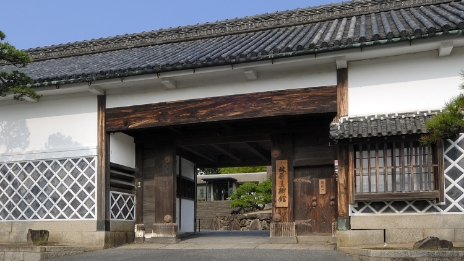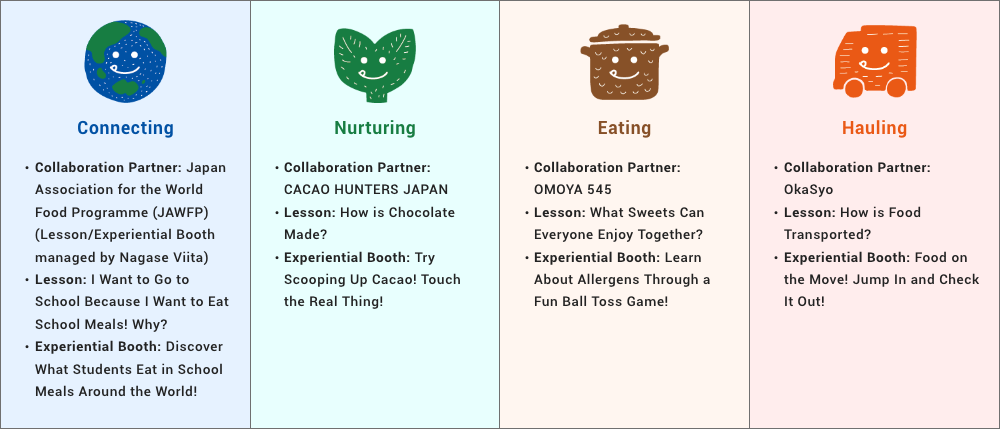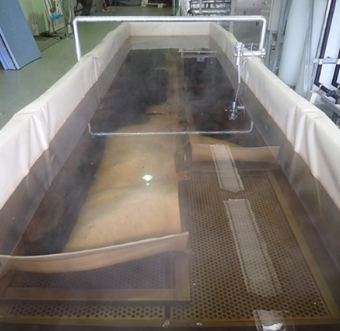
Social Contributions
Our Social Contribution Activities
As a company, we are committed to contributing to society through our business activities and to build positive relationships with our local communities. Our extensive social contribution activities support the development of culture and sports, including operating the Hayashibara Museum of Art and holding SCHOOL OF FOOD, as well as organizing events and gatherings to promote interaction and constructive communication with the local community.
Support for the Hayashibara Museum of Art
The museum houses a collection of Japanese and other East Asian paintings, crafts, and miscellaneous items. It also exhibits furnishings inherited from the estate of the Ikeda feudal clan of the Okayama domain. The collection includes three national treasures and 26 important cultural artifacts, such as swords and other arms, armor, paintings, writings, Noh masks and costumes, carved lacquer, mother-of-pearl works, lacquerware, ceramics and metal works.
By supporting the Hayashibara Museum of Art, we contribute to the recognition of the rich culture and history of our community, and help preserve these cultural assets for future generations.


SCHOOL OF FOOD
In FY2024, Nagase Viita launched a collaborative food education project called the SCHOOL OF FOOD for the children who will lead the next generation. This project aims not only to help children make healthy and environmentally-conscious food choices, but also to draw attention to the food issues and environmental impacts facing society as a whole. The first session of the SCHOOL OF FOOD highlighted four themes—connecting, nurturing, eating and hauling—with the support of four collaboration partners.


▶Related article:
SCHOOL OF FOOD: From Afternoon Snacks to Global Food Issues—A Food Education Project for Children
Nagase Viita Life Seminar (FY2017–FY2023)
Since FY2017, we have been hosting the Nagase Viita Life Seminars, a public lecture series aimed at social contribution. These seminars focus on everyday topics and provide practical, easy-to-understand information that people can apply in their daily lives.
| Seminar 1 | Saturday, February 10, 2018 | "Consuming delicious food that adds joy to our lives" Lecturer: Ms. Setsuko Kanaya (Director, Kanaya Institute of Nutrition) "What is ‘Trehalose’?" Lecturer: Ms. Natsuko Sato (Registered dietitian, formerly Hayashibara Co., Ltd.) "Meals for elderly diabetic patients prepared by dietitians and patients" Lecturer: Ms. Yoshiko Fukushima (Registered dietitian, Taniguchi Internal Medicine Clinic) |
|---|---|---|
| Seminar 2 | Saturday February 23, 2019 | "Food news: True or false? How to think scientifically to identify fake news" Ms. Waki Matsunaga (Scientific journalist) |
| Seminar 3 | Tuesday, October 20, 2020 | "Nutrition and health: Prevent metabolic syndrome with a moderate appetite and protect against frailty with a solid diet" Dr. Teiji Nakamura (President, Kanagawa University of Human Services / President, Japan Dietetic Association) |
| Seminar 4 | Monday, March 7, 2022 | "Whole-body health starting from the mouth: Live a long and healthy, hydrated life" Dr. Ichiro Saito (Professor, School of Dental Medicine, Tsurumi University) |
| Seminar 5 | Monday, March 13, 2023 | "A healthy body and mind through gut health! Diversity of intestinal bacteria is the secret to healthy longevity." Dr. Yuji Naito (Professor, Kyoto Prefectural University of Medicine) |
| Seminar 6 | Tuesday, March 19, 2024 | "An era is coming when aging can be prevented and treated! Aim for healthy longevity by slowing down the aging clock!!" Prof. Hidekazu Yamada, M.D., Ph.D. (Kindai University, Anti-aging Center Founder / President of Japanese Society of Anti-Aging Medicine) |

Hosting the Okayama Wellness Event (FY2020–FY2024)
As part of our commitment to one of our key materiality goals—Contributing to Increasing Health and Life Expectancy—Nagase Viita launched a healthy living event in Okayama City in FY2020. Since FY2022, we have been running a program called Okayama Wellness that brings together companies and organizations involved in food and health in Okayama City and beyond. Through activities such as physical fitness tests and health checkups, we continue to support health awareness and improvement in local communities.

Sponsorship for Sports and Culture in the Community
To give back to the community through sports and culture, we sponsor a variety of organizations in Okayama. Notably, we have been the club sponsor of Fagiano Okayama, a J1 soccer team, since 2016. We also serve as a supporting member of the Okayama Philharmonic Orchestra, an orchestra based at the Okayama Symphony Hall.
Protection of Cultural Assets Using Our Products and Technology
To help conserve the rich cultural history of our local community, we have used our enzyme technologies to develop important materials to be used for protecting cultural assets.
Conservation of Buried Cultural Properties Using Trehalose
The organic artifacts found in excavations — such as wooden boats, farming tools, and lacquerware — have been significantly weakened by microbial damage and excessive water content, and are at risk of severely shrinking and breaking if left to dry. Keeping these objects in good condition requires a conservation treatment that replaces water with a stable substance to maintain a dry state.
Conventionally, the polyethylene glycol (PEG) impregnation method has been used to conserve excavated wooden objects. However, the lengthy time of the impregnation process proved to be problematic. And in the case of wood-iron composites and items excavated from underwater sites, the material deteriorated after the impregnation treatment. To resolve these issues, the trehalose impregnation method was developed by a research group led by the Conservation Science Office of the Osaka City Cultural Properties Association. This method is now widely used and promoted both in Japan and overseas. In March 2021, the impregnation treatment was completed for an approximately 5.6 m bulkhead plank of a sunken, invading Mongolian ship excavated from an underwater site in Takashima, Matsuura City, Nagasaki Prefecture. And in October 2022, conservation treatment began on a large wooden anchor salvaged from the sea floor, with significant results demonstrated thus far.


Left: Immersing a bulkhead plank in a heated aqueous trehalose solution
Right: Solidified trehalose soaked into the bulkhead plank
▶Related article: Sustainable Story 07
The Trehalose Application in an Unexplored Area: Conserving Buried Cultural Properties for the Future
Developing Alternative Aged Wheat Starch Paste, Essential for Repairing Hanging Scrolls and Horizontal Scrolls, through Enzyme Technology
Aged wheat starch paste is an essential adhesive for repairing cultural artifacts made of Japanese paper, such as hanging scrolls and horizontal scrolls. Thanks to its unique properties, this paste ensures that paper does not harden after drying, prevents mold from growing, and easily peels off with water. In the repair studio, art conservation experts produce this paste by maturing boiled wheat starch for 10 years. This process takes an enormous amount of time and effort, and ensuring a stable supply can be difficult. In partnership with the Tokyo National Research Institute for Cultural Properties and Oka Bokkodo Co., Ltd, (a cultural goods repair company), Nagase Viita began to jointly develop an alternative to the traditionally made aged paste. Together, we succeeded in producing an alternative aged paste through enzyme technology that can be produced in only two weeks.

Left: Alternative aged paste manufactured by Nagase Viita
Right: Aged paste manufactured with traditional methods
Mass-Production of an Enzyme to Remove the PVA Membrane Applied as an Anti-Delamination Agent on the Surface of Cultural Artifacts, such as Mural Paintings
Polyvinyl alcohol (PVA), used to protect murals in architecture, deteriorates over time and can cause damage to the surface on which it is applied. Art restoration experts have long been concerned about removing it safely without damaging artworks. The Osaka Research Institute of Industrial Science and Technology has developed an enzyme that breaks down PVA. Nagase Viita produces this PVA-degrading enzyme and provides it to the Tokyo National Research Institute for Cultural Properties for use in art restoration to ensure that the PVA can be safely removed without damaging the art.

